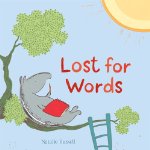I love picture book that have pages full of detail-rich scenes. Richard Scarry's books, which I looked at over and over again when I was little, are like this. Now many other illustrators are creating wonderful books full of artwork that readers can explore. What is wonderful about these books is that one does not need to be able to read to see and follow the stories in the artwork. Today's picture book is a wonderful example of just such a book.
 Busy Bunny Days: In the town, On the Farm and At the Port
Busy Bunny Days: In the town, On the Farm and At the Port
 Busy Bunny Days: In the town, On the Farm and At the Port
Busy Bunny Days: In the town, On the Farm and At the Port
Britta Teckentrup
Picture Book
For ages 4 to 7
Chronicle Books, 2014, 978-1-4521-1700-3
The Bunny family members have busy lives and we are going
to spend a little time with them, getting to know them and getting to know
their world. We are going to begin by visiting them in their hometown.
Here we are and
it is six o’clock in the morning. The day is just beginning, and yet there are
a few folks out and about. One gentleman is walking his dog and we see that the
garbage collectors are hard at work. Unfortunately, they have dropped a banana
peel and someone has stepped on it and slipped. In their house the Bunny family
members are beginning their day. Bethany Bunny is eating her breakfast and
Baxter Bunny is just getting out of bed. Dr. Bunny is shaving in the bathroom.
By nine o’clock
the streets are full and busy. An ambulance is picking up the animal who
slipped on that pesky banana peel, and the children from the neighborhood are
walking to school or getting on the school bus.
At midday rain
starts to fall on the town. Dr. Bunny is busy taking care of his patients and
Bethany and her kindergarten classmates are getting ready to go for a walk.
Grandma Bunny has done some shopping and she is on her way to the Bunny home.
She will be there to give Bethany her snack when the little girl gets home from
kindergarten.
Later on in the
afternoon there is a little drama when a small fire breaks out in the attic
apartment in the Bunny’s building. Benny Badger gets up to his old tricks when
everyone is distracted by the fire.
After visiting
the Bunny’s hometown we go to a farm with them and then we visit a port. In
each case we share a whole day in their company, seeing the little events that
make daily life interesting. We also get to watch the little adventures that
the characters in the book have.
Children are
going to love exploring the artwork in this wonderful picture book. They will
see days unfold before their eyes, and watch as the small joys and woes of
everyday life are played out on the pages. They will have fun looking for Benny
Badger, who is always getting into trouble, and will enjoy answering the
questions that appear on every spread.




